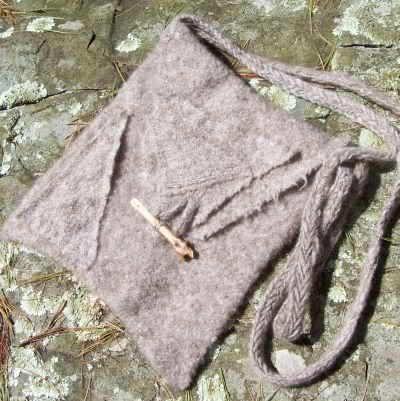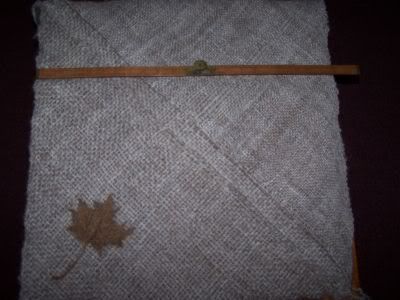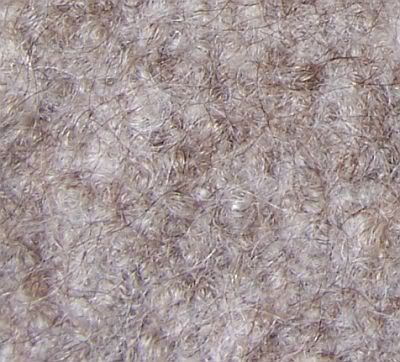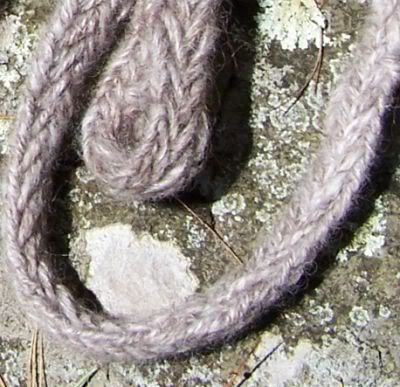
And I use the word "vadmal" loosely..it may not be actual or true vadmal (wadmal).

According to the little bit of information I was able to find online, Kerstin Gustafsson explains in her book Ull (Wool) that there isn't any given measurement, but cloth will be called vadmal when it is so tightly stamped that no warp or weft threads can be pulled out of a cut edge.

Gail Lambert writes in her thesis (The Taxonomy of Sweater Structures and Their Origins) that valmal is a woven and then felted fabric, and was once accepted internationally as currency.

I was able to find a page that indicated that in medieval Iceland and Norway, wadmal was a standard item of barter. Six ells (or about 6 yards) of wadmal were equal to 1 eyrir, 24 grams of silver: 8 eyrir made a silver mark.

I found out that wadmal cloth was woven on the warp - weighted loom..my bag was woven on the triloom..so...I guess it isn't really historically correct...sorta faux vadmal..

Project notes:
The fiber for this bag was spun from Icelandic Sheep raised by Susan Mongold Briggs. Purchased in the form of a batt from Tongue River Farm. This fiber could not be nicer, I was extremely happy with the quality. It was so beautifully prepared, that it begged to be spun on my Great Wheel. I spun singles on the Great Wheel, and then plied the singles on my Ashford Traditional. I then wove 5 triangles on the 3 foot triangle loom. Four of the five were woven normally, with the fifth triangle using a closer sett. This was achieved by doubling the strands on each nail. Then the triangles were positioned in the fashion of the bag. The pieces were then slip- stitched together. The size before the fulling process was a 23 inch square, and afterward it measured 13 inches by 14 inches. I then scissor trimmed the flap to a size and shape that I found suitable. The straps were made by spinning the double ply in Navajo ply fashion, and then fingerlooping a braid that was handstitched onto the edges of the bag. The button was fashioned from a branch of a maple tree, that I shaped and hand finished. A smaller piece of fingerlooping that was braided with the double ply, serves as a button hole.



8 comments:
Beautiful bag!
And an excellent understanding of vadmal! (as far as I know, anyway....not an expert, just an interested viking re-enactor textile geek) ;)
Was the tog and thel separated before you spun the fleece?
Oh! and let me know if you ever decide to try the warp-weighted loom - I'm quite simply craving the company of other weavers who use it. There's so much to learn in the practice of it.
Karen
I loved the bag. It was good to see you today, I just wish we had more time to get together like days of yore! I think we all need a day to get together and spin..now if time and obligations would just allow it.
What a beautiful bag! Your work is lovely! Thanks so much for the education on vadmal. :-)
Incredible. Your bag is beautiful and looks connected to the earth to me. Not being a spinner or weaver, it is a joy to learn from you. The button is in perfect harmony with the bag. Lovely, Cyndy!
The bag is beautiful, organic in appearance, geometrically appealing. The little maple twig, used as a clousure was a perfect choice. I need to learn to finger weave. You are quite an inspiration. Hope your weekend is as lovely as it is here.
Love that bag! And thanks for the history lesson as well. Nice!
Hi there. I have been researching vadmal recently and have come across the scholarly work of Michele Hayeur Smith. At the beginning of last decade, Smith conducted a pioneering survey of the archeological textile finds in iceland, and also reviewed the scholarly literature on vadmal history and terminology. She wrote a book from her research which is very expensive and I haven’t read, but you can download a brief summary of her research in her paper, Thorir’s Bargain: Gender, Vadmal, and the law. I think you would find this to be a very interesting article. She goes into the changes in spin direction throughout the centuries, the warp thread count of differing categories of vadmal and when those categories may have been codified and the differing lengths of the ell throughout the centuries. Unfortunately, I did not find the answer the question I have which is, “how many sheep, and how many wethers vs. rams vs ewes would one need to keep of historical Icelandic sheep to produce 1 eyrir of simple 2/2 twill vadmal at 10 warp threads per centimeter.” Any guesses? Thank you.
Hi David,
Thanks for your comment, and thanks for the information on the about the work of Michele Hayeur Smith.
Your question is hard to answer.
There are many variables involved.
First thing to consider is the average amount of wool from the individual sheep. On average, in today's world, one could expect to collect about 5 to 6 pounds of wool from an Icelandic sheep. The rams usually yield more wool because of their size. Then you would need to consider the grist of the yarn spun, or yards per pound. An average grist would yield about 830 yards to a pound of wool. Then you have to figure the amount (yardage) you would need for both your warp and weft for the length and width of the cloth (add in for things like take up and so forth). So my best guess would be 2 or 3 sheep could produce enough wool for that vadmal. I think you would need about 17 pounds of wool overall..give or take ....
Post a Comment